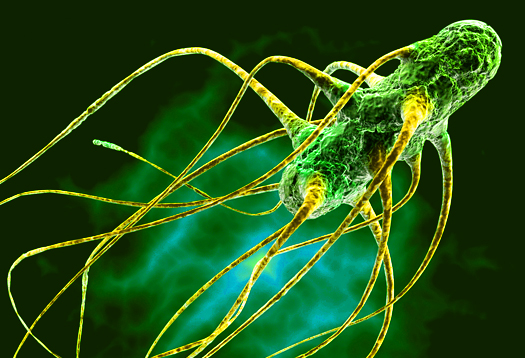Research team searches for salmonella vaccine
Federica
Giannelli, University of Saskatchewan
 At
the University of Saskatchewan, researchers have been working on a novel salmonella vaccine that
holds promise for preventing this food-borne infection.
At
the University of Saskatchewan, researchers have been working on a novel salmonella vaccine that
holds promise for preventing this food-borne infection.
The vaccine, being
developed at the university’s Vaccine and Infectious Disease Organization —
International Vaccine Centre (VIDO-InterVac), has shown positive preliminary
results in animal models.
“As
salmonella strains are becoming more antibiotic-resistant, treating the
infection is more difficult,” said VIDO-InterVac scientist Aaron White, U of S
Jarislowsky Chair in Biotechnology.
Salmonella
infection causes gastroenteritis which involves vomiting, fever and diarrhea.
People can get infected by eating contaminated meat, eggs, or milk, or when
foods have come into contact with manure. Pets such as cats, dogs, and reptiles
may also carry and spread the infection.
White’s
PhD student Akosiererem Sokaribo has genetically modified a salmonella strain
to generate a new variant that produces high quantities of the vaccine antigen,
a molecule that induces immune responses to the bacteria.
“Our
vaccine may be unique for its potential to protect against multiple salmonella
strains because it relies on an antigen that is common to the strains that
cause gastroenteritis,” said Sokaribo, a student who has come from Nigeria to
VIDO-InterVac for the opportunity to work at a world-class institute for
infectious diseases and vaccine research.
“With
more than 1,500 salmonella variants causing gastroenteritis, so far it has been
difficult for researchers to develop a vaccine that could work for all,” she
said.
“Delivering
a low-cost vaccine is important, especially in low-income countries where
salmonella remains a huge burden."
Sokaribo
has tested the novel vaccine on more than 50 healthy mice to determine whether
their immune systems were activated. All animals showed a strong immune
response to the vaccine.
“This
is a very good sign. If we didn’t get any immune response, it means the vaccine
would not work,” said Sokaribo.
She
presented her results on June 25th at the fifth International
One Health Congress in Saskatoon, organized by the U of S and the One Health
Platform.
The
team’s next step is to test the efficacy of the vaccine in protecting mice
against salmonella infection, and they hope they will complete the new trials
by the end of 2018.
Even
though it was a preliminary trial, Sokaribo said the testing was a success
because she was able to purify the antigen in large quantities. This means
potential costs could be reduced if the vaccine enters production.
“Delivering
a low-cost vaccine is important, especially in low-income countries where
salmonella remains a huge burden,” said White.
The
researchers’ vaccine potentially targets both humans and animals. The work is
an example of the U of S excellence in One Health research that focuses on the
interconnectedness of human, animal and environmental health.
The
project has been funded by the federal Natural Sciences and Engineering Research
Council (NSERC), the Saskatchewan Health Research Foundation (SHRF), and the
Jarislowsky Chair in Biotechnology through combined funding from the U of S,
the Saskatchewan government and Stephen Jarislowsky, a Montreal businessman who
has established a philanthropic legacy of supporting research in Canada.
Federica
Giannelli is a graduate student intern in the University of Saskatchewan
research profile and impact unit. This content runs through a partnership with
The StarPhoenix.